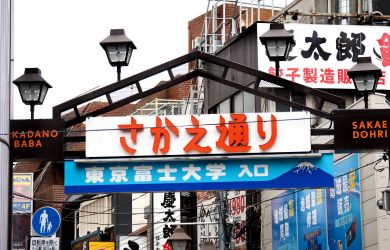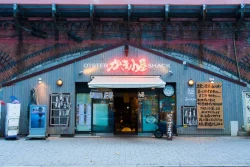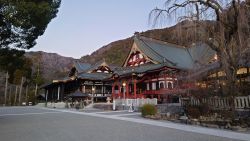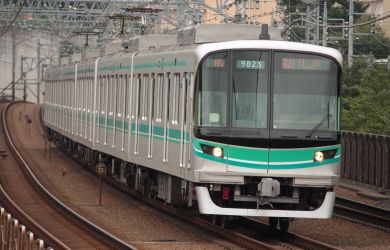
March 17, 2006
Storm Damage
Devastated by a volcanic eruption six years ago, the island of Miyakejima is back in business—sort of
By Metropolis
Originally published on metropolis.co.jp on March 2006

Photos by William Bonds
Miyakejima, one of the Izu islands south of Tokyo, was once a haven for flora and fauna. Things changed dramatically in June 2000, when Mt. Oyama, the volcano that forms most of the island, started its biggest eruption in 2,500 years, killing trees, animals and anything that could be called a tourist industry. The islanders were evacuated, and Miyakejima was put into quarantine for nearly five years.
When the restrictions were eased a year ago, some of the locals returned, but with the volcano still bubbling away and spewing out gas, it was hardly a welcoming homecoming for those trying to pick up the pieces.
And there were plenty of pieces. Some villages remain ghost towns with roofs exposed to the elements and only the sound of construction vehicles disturbing the peace. You can still drive around the island on the newly repaired road; you just can’t stop in certain places. Sirens and color-coded lights tell citizens which way the gas is headed. You can buy a gas mask before you board the ferry.

The overnight ferry is the only way to get to the island while the airport remains shut. It’s a six-and-a-half hour journey in fairly spartan surroundings—no discos and comfy chairs here. Well, not many. On the upper decks, those in the know unfurl their blue plastic groundsheets and unpack the beer and dried fish for an all‑night party, while others head for the tatami-mat areas downstairs (numbered and allocated; you get about a 1 x 2m space).
It’s comfortable enough to get some sleep, but it’s a lot more fun sipping beer up above with the wind howling through your hair as you pass under Rainbow Bridge, glide past Haneda, and wave goodbye to Tokyo. The ferry also goes to Hachijojima, further south of Miyakejima, so you don’t want to miss your port of call.
I awoke to a blast from the ship’s horn with a throbbing head after about three hours’ sleep (and three hours’ beer) and peeked outside to see the vessel bobbing violently up and down as it maneuvered into the jetty at Miyake, one of two possible ports of entry to Miyakejima. The Pacific Ocean currents do not make docking an easy task, and there are times when the boat simply can’t moor because of the size of the swell.
Stepping off the ship, the island presents a bleak view. Mt. Oyama is surrounded by cloud, the weather is cool (it is 5am), and there’s a massive chunk of black volcanic rock right in the middle of the port to remind you that this is a volcanic island, and a dangerous one at that.
The ship actually docks in an area near the (closed) airport that’s off‑limits to the general population, and at 5 o’clock in the morning, you’re not going to find any public transportation to get you anywhere (although buses do run around the island). Accommodation is also very limited.

The Kairaku Hotel on the west of the island is virtually the only place to stay, although there are a several ryokan/minshuku available. In other words, you’ll have to have this (and a dockside pickup) sorted out before you arrive, or you’ll end up lying on a bed of sulfur dioxide.
Miyakejima is no tropical paradise. The weather can be scorchingly hot, but the mountain can also create cool clouds. All the beaches are black, and don’t expect a conbini on every corner. Or, indeed, any corner. Finding food is not easy. The Kairaku has a restaurant, but there are few other walk-in hostelries on the island (although there are a couple of “snacks”).
Miyakejima is an island that’s still recovering. And trying to rebuild its tourist industry. You can swim with the dolphins, dive around the coral, and go bird watching or fishing. If you can borrow or rent a car, you can drive around the island and see the devastation alongside heavy vegetation, but little else. The reality of Miyakejima is that there’s little to do.
While the national and Tokyo governments have done well to rebuild the island’s physical infrastructure, the human infrastructure remains frail. Many people simply haven’t returned and, as a result, the human presence on the island lacks, well, presence.
If the volcano decides to calm down and the poisonous gases disappear, Miyakejima stands a slim chance of revitalizing itself. But with the smell of sulfur in your nostrils as you leave, that day still seems a long way off.
The only way to reach Miyakejima from Tokyo is by ferry from Takeshiba, near Hamamatsucho. The ferry departs daily at 10:30pm and arrives at 5am, usually docking at Miyake on the east side of the island (Ako on the west side is sometimes used as an alternative). The cost one-way is ¥6,330. While Miyakejima does have an airport, it is currently closed. The Hotel Kairaku (Tel: 04994-5-0131/2, fax: 04994-5-7385, http://sv07.wadax.ne.jp/%7Emhotelk-com/) is in Ako town, although there are various pensions and minshuku in Ako and other parts of the island. Check the websites below for more information. Accommodation rates start at around ¥6,000. Expect to eat a lot of fish. If you catch your own, the Kairaku Hotel (and other accommodations) will prepare it for you for a small fee. The hotel can also arrange fishing or diving trips and has fishing gear available for guests. Only NTT Docomo phones can be used on the island. For more info, see the following Japanese websites: www.miyake-eco.net, www.miyakemura.com, www.miyakejima.gr.jp, www.miyakejima.net
[geo_mashup_map]




①_Panoramic-ViewDay1-Medium-390x250.jpeg)


